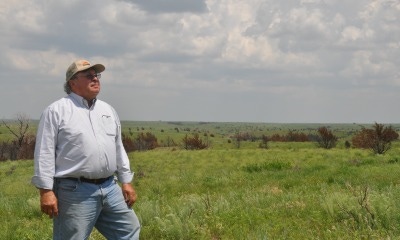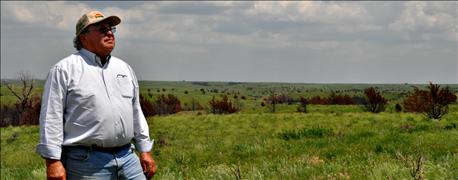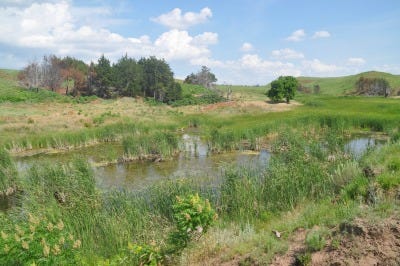
Barber County rancher Ted Alexander sees a golden opportunity arising from the blackened ruins of the wildfire that ripped through the Gypsum Hills west of Medicine Lodge at the end of March.
"We have been handed a gift by Mother Nature -- the destruction of tens of thousands of invasive red cedar trees. In the coming months, we have the opportunity to finish the job she started and reclaim the ecosphere of the Red Hills," Alexander said.
Across the 625 square miles of burned landscape, healing has already begun. Native mixed grasses have turned the black pastures green and wildflowers abound. The black skeletons of dead, burned trees stand out starkly.
Those skeletons are a problem.

CEDAR INVASION: Gyp Hills rancher Ted Alexander has been fighting the invasion of red cedars with clipping and fire for 30 years. He says the widespread fire presents an opportunity to reduce the threat from red cedars by preventing them from re-growing.
"The worst thing is they provide perches for all kinds of birds that leave behind seeds. In a year, you will see hundreds of tiny red cedar trees all around those skeletons," he said. "It's just the way it works."
RELATED STORIES:
Details on the initiative and its priorities
Five top ways to build on the advantage from fire
Alexander sees a solution. He's calling it the Anderson Creek Wildfire Initiative. With more than a dozen partners on board, the Initiative is trying to raise $1 million to provide cost-sharing funds to landowners in the region to clean up an initial 33,000 acres of the more than 400,000 that burned.
The estimated cost of the full Initiative is $56 million.
"The challenge is we have to act fast," said Todd Kelly, who is leading the fundraising side of the effort.

WATER GAINS: The elimination of thousands of red cedar trees means a huge gain for water quantity and quality if re-infestation can be prevented.
"We have to act right now to prevent the reinvasion of cedars, the introduction and spread of noxious weeds, not to mention water and wind erosion and the loss of other parts of the ecosystem."
Alexander said the initial effort will be targeted to remove dead standing trees and to clip any living cedars along the most productive part of the Red Hills pastures -- the tops or ridges.
The next priority will be the cleanup of riparian areas and the third will be the restoration of wildlife habitat, especially for the lesser prairie chicken.
Finally, the Initiative will focus on the re-establishment of native areas and forbs and the monitoring and control of noxious weeds.
About the Author(s)
You May Also Like






